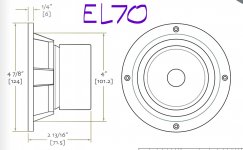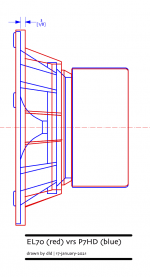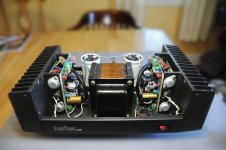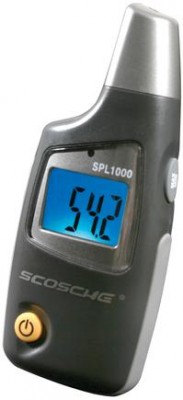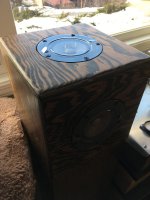It is a big paradigm shift for me to be thinking about reversing decisions I made and components I chose based on the EL70 roll-off. Everything from DAC chips, to opamps, to tubes in my amps, I have always chosen the "brightest" most "analytical" in order to squeeze what I could out of those drivers.
I probably should have done what you did and thrown some super-tweeters into the mix rather than brightening up the entire system. Whatever, hindsight is 20/20. It won't be difficult to bring the balance back. In fact, it will be enjoyable. 🙂
I probably should have done what you did and thrown some super-tweeters into the mix rather than brightening up the entire system. Whatever, hindsight is 20/20. It won't be difficult to bring the balance back. In fact, it will be enjoyable. 🙂
I forgot to mention that I wired up the 16 ohm taps on my Tubelab SSE last night. With approximately 12 ohms of speaker impedance connected, the result is 3.75k ohms of primary load on the tubes (vs. 5k ohms ideal SSE design spec). With 12 ohms on the 8 ohm taps, the resulting primary load is 7.5k ohm.
Reducing primary impedance increases power and distortion, and increasing primary impedance reduces power and distortion. However, it is not linear and the computer modelling is not perfect. In the end, it is a matter of looking at output tube specs and using ones ears.
In this case, I have chosen the 16 ohm taps because a) EL34, 6L6, KT-88, etc. can easily handle loads as light as 3.6k ohms, b) SE Amp CAD shows a negligible increase in distortion, c) I get a bit more power, and d) it sounds excellent to me.
Not really important to anyone but me, however someone may find this useful if they are running a tube amp and considering microTowers with dual P7.2HD.
Reducing primary impedance increases power and distortion, and increasing primary impedance reduces power and distortion. However, it is not linear and the computer modelling is not perfect. In the end, it is a matter of looking at output tube specs and using ones ears.
In this case, I have chosen the 16 ohm taps because a) EL34, 6L6, KT-88, etc. can easily handle loads as light as 3.6k ohms, b) SE Amp CAD shows a negligible increase in distortion, c) I get a bit more power, and d) it sounds excellent to me.
Not really important to anyone but me, however someone may find this useful if they are running a tube amp and considering microTowers with dual P7.2HD.
I'm hopeful the 12Ohm impedance won't be a big deal for my amps.
When comparing the technical drawings for both drivers, it looks like you were right with the 3mm estimate of the P7HD sitting proud of the baffle.
I did some cursory research for gaskets to fit, and am convinced I'll do the same as you with cardboard and the existing gaskets.
When comparing the technical drawings for both drivers, it looks like you were right with the 3mm estimate of the P7HD sitting proud of the baffle.
I did some cursory research for gaskets to fit, and am convinced I'll do the same as you with cardboard and the existing gaskets.
Attachments
The change from 8 ohm to 12 ohm will be no problem for your ss amp. In fact the higher impedance will be easier on the amp. Higher impedance will equal less current flowing. The dh200 is a great amp... I can only imagine the one you’ve modified will be even better.
Last edited:
Cheers, Evan, thanks. I am excited to liven up my microTowers with new drivers. The cabinets you built all those years ago still look fabulous.
The dh200 is a great amp... I can only imagine the one you’ve modified will be even better.
As it came in the day it was competitive but it by today’s standards, is not a great amp. Modified it could well be.
dave
I’m glad the cabinets are holding up well
The hafler amp is simple and well made. Attested to by the fact that it’s around 45 years old and still works well. I can’t remember absolute numbers but I did look at the fft of this unit a couple years ago and was surprised to see mainly second order distortion at up to quite a few watts.
The hafler amp is simple and well made. Attested to by the fact that it’s around 45 years old and still works well. I can’t remember absolute numbers but I did look at the fft of this unit a couple years ago and was surprised to see mainly second order distortion at up to quite a few watts.
I sold the board on my last one, i still have the PS and chassis for another amp.
My biz partner built well over 100 of the kits for our customers (long before we were partners).
dave
My biz partner built well over 100 of the kits for our customers (long before we were partners).
dave
So I would say my P7.2HD drivers are fully broken in at this point. I have not driven them to distortion or exceeded xmax, or anything reckless like that, but lets just say the moving parts are certainly compliant at this point. 🙂
They've really smoothed out. Bass through to lower midrange has fully developed now. Yet, that sparkling top end is still there. I am even more pleased with them now. There isn't really anything missing except for the obvious SPL limit, which I don't find limiting at all. During my testing I was seeing SPL peaks well into the mid-90dB and a couple up to 100dB (at the listening position) which is actually far louder than I listen 99% of the time.
10 out of 10.
They've really smoothed out. Bass through to lower midrange has fully developed now. Yet, that sparkling top end is still there. I am even more pleased with them now. There isn't really anything missing except for the obvious SPL limit, which I don't find limiting at all. During my testing I was seeing SPL peaks well into the mid-90dB and a couple up to 100dB (at the listening position) which is actually far louder than I listen 99% of the time.
10 out of 10.
My biz partner built well over 100 of the kits for our customers (long before we were partners).
Yeah I always wondered about that when you could buy them factory built? Were the kits that much cheaper?
jeff
It was cheaer to pay Chris to build them than getting factoy built ones. And he did a better job.
NAD 3020 or Advent 300 and Hafler DH200 were a common pairing.
dave
NAD 3020 or Advent 300 and Hafler DH200 were a common pairing.
dave
A lifetime ago, that was. The DH200/220 was a much simpler build than the original preamp, but the DH500 was a beast
Hey von Ah, here's a tip you might find useful (although I am sure it may have occurred to you anyway).
Save the plastic protective covers that are shipped on the P7.2HD drivers and use them to cover the drivers when not in use.
The only real peeve I have about the microTowers in the "Castle" configuration is how much dust and grime the top drivers collect over time. I often thought about making grilles with acoustic fabric but never got around to it.
This is a pretty simple solution and has already proven itself. Also reduces risk of accidental damage due to pets, careless vacuuming practices, thrown objects, etc. etc. 🙂 I cover all 4 drivers, because - why not?
Save the plastic protective covers that are shipped on the P7.2HD drivers and use them to cover the drivers when not in use.
The only real peeve I have about the microTowers in the "Castle" configuration is how much dust and grime the top drivers collect over time. I often thought about making grilles with acoustic fabric but never got around to it.
This is a pretty simple solution and has already proven itself. Also reduces risk of accidental damage due to pets, careless vacuuming practices, thrown objects, etc. etc. 🙂 I cover all 4 drivers, because - why not?
Attachments
Last edited:
Member
Joined 2009
Paid Member
I’d suggest using a router to create a small rebate / ditch in a square shape, set back from the edges and fashion a grill cloth to sit on top with the cloth fixed to a square frame that simply drops into the routed slot.
- Home
- Loudspeakers
- Full Range
- microTower Revisited
